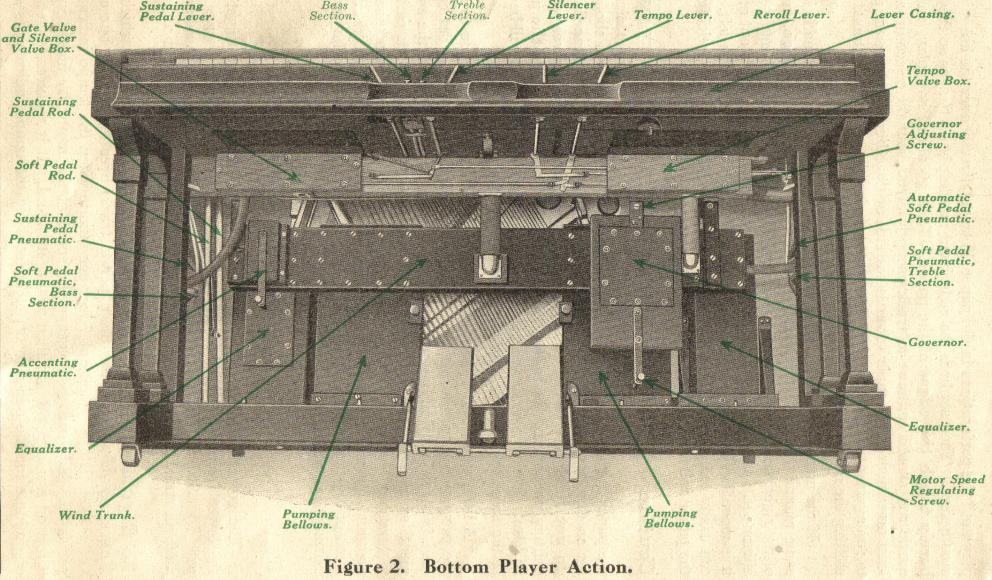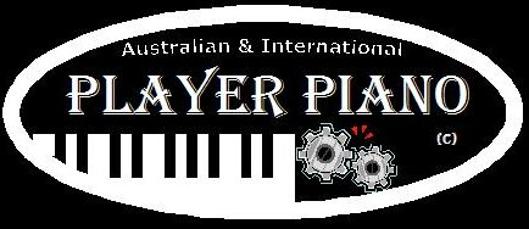
The piano is the monarch of all musical instruments. Without it, some of the greatest compositions ever written, could never have been born. It is an instrument of pure elegance with massive musical command and range.
There is nothing inside a regular piano, that is not found inside the player piano. A properly regulated player action mated to its piano action, will perform with absolutely the same touch, when hand played.
The player piano is not a gimmick. It was and is, a serious device, invented, not only for profit, but from a desire to deliver high quality music into the living rooms of families before television, radio and even before the Phonograph, were available.
The principal of player operation is simple pneumatics, the application of force to perform a task
Newton's Second Law of Motion: Force = Mass * Acceleration or F = ma
Put simply, the player piano generates and uses negative air pressure, or vacuum, against positive air pressure, or atmosphere, to create an environment that will allow valves working under negative pressure, to control the collapse (vacuum) or relax (atmospheric pressure) of pneumatics, to achieve movement of the pneumatic to strike a note. It really is just that simple, a method of making negative and positive air pressures perform a task. As with all other things, negative affects positive and vice' versa. Valves are simply an on/off switch, controlled solely by the inlets in the tracker bar, or more specifically, the paper music roll perforations. There are some devices to control the finesse of the movement (slow or fast/soft or hard), and these are known as 'expression' or 'reproducing' mechanisms.
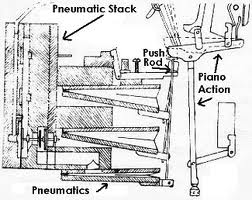
The Piano Action. In addition to self play the action is able to be played by depressing the keys as with regular pianos, the piano mechanism is basically the same as in a non-self playing piano. Usually requires all felts and leathers to be replaced when restoring, and must be lubricated and regulated to perform properly. As most all moving parts are wood, lubricate with dry graphite only.
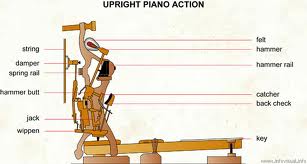
The Player Mechanism: Consists of a 'Stack' that includes spoolbox and roll wind motor. Peripheral pneumatic devices for sustain, expression, and roll tracking or centering. And a large bellows that sits in the base of the piano and may be operated by pumping the foot pedals. Some expression and reproducing models were built with electric suction pumps.
The stack is comprised of two or three tiers of small striker pneumatics glued to a board. The boards contain air channels that direct the suction produced by the foot bellows or electric pump, to each of up to 88 pneumatics (one for each key). There are two systems; single valve and double valve. As the perforated piano roll runs down the tracker bar, the admitance of air through each perforation activates the corresponding valve, inflating a leather pouch to divert the suction to collapse the striker pneumatic, thereby causing the piano action to respond with the sounding of a note . In a well regulated player this action can be repeated 8 times per second. The single valve system is compact and was a design improvement. The double valve system uses a small primary valve to activate a larger valve that in turn collapses the striker. The primary valves may in some cases be located seperately from the stack.
Refer to Arthur Reblitz Book Player Piano Servicing and Rebuilding for comprehensive instructions in the art of player piano rebuilding.
The following two video clips demonstrate (A) How a bellows system works. (B) Aspects of the piano and player actions working together:
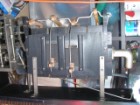
Wind motor, drives the roll for both play and re-wind
Pouches made of fine pneumatic leather, and sealed with egg white to ensure an inflatable airtight action
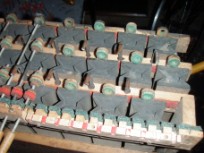
Three tiers of (unrestored) striker pneumatics that make up the stack
Here are Aeolian valve assemblies. Activated by the inflation of the pouch as air is admitted to each pouch.
The Bellows or suction unit
Most player pianos are fitted with a foot operated bellows unit that sits in the base of the piano. Two flip out treadles are housed behind a slide or trap door and are extended to use. The bellows are usually made up of two exhauster pneumatics that are connected directly, one to each treadle. Both exhausters are attached to a large pneumatic called the reservoir. There are two sets of flap (one way) valves that allow the exhausters to extract air from the reservoir continuously, which in turn provides a 'reservoir' of negative pressure (suction) that the player requires in order to operate. As each treadle is depressed air is displaced from the exhauster and that air is outlet through the one way flap valve on the exterior of the exhauster. As the treadle is released, under spring tension, air is displaced from the reservoir through an internal flap valve into each exhauster.
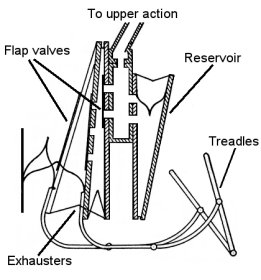
Most reproducing and some expression players are fitted with a motor driven suction bellows that utilizes a cam to open and close the exhausters. These exist in many forms, the unit shown below uses the top cam to open each of six extractors and is run by belt drive and a small electric motor. Very efficient and quiet in operation, which is essential to the performance of a reproducing player, specially when playing very soft passages.
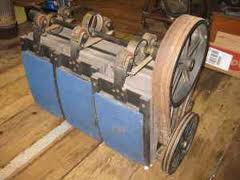
Another form of pump is the electronic vacuum motor box. These are still made and may be purchased to electrify most any player. Also very quiet in operation, the vacuum developed can make up for severely leaking systems. One original vac motor system that was sold with some reproducers and standard players called 'Electora' and was manufactured by the Motor Player Corporation during the 1920's. These systems feature baffled exhaust and sound deadening materials, the motor is held in suspension by springs to reduce vibration and noise transfer. Low maintenance. I have an Electora that was built in 1927, this unit functions perfectly and has had bearings and carbon brushes replaced in 2010. Not a bad record of performance. The kit pictured below will fit into the base of most players without significant modification. It is advisable to retain the original bellows, as the electric units will hose fit into the reservoir. Available to purchase from: Mr. John Tuttle of Player-care. Player- care presents a wealth of piano and player information, sales of spare parts, accessories and repair/restoration materials plus sales of QRS music rolls:
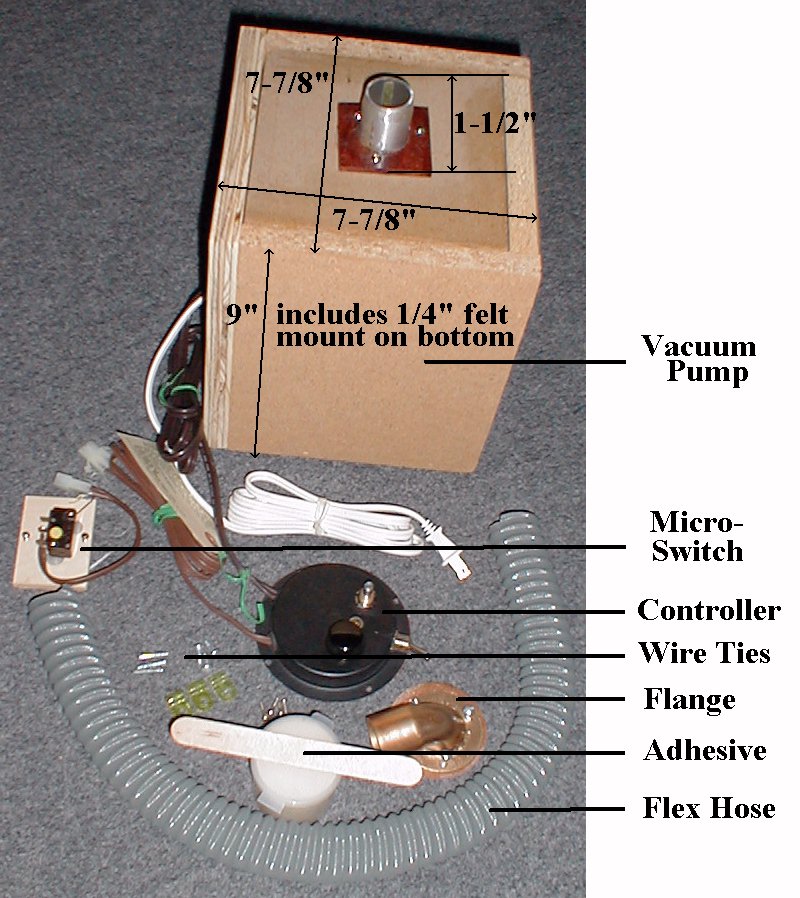
What gives my piano it's character
Many factors influence the sound of the piano. Piano's built on the same factory lines to exact specifications can sound different. Imperceptible differences in the timbers of the soundboard, case, finish coatings, strings and hammers, all exert an influence on what we will term the 'character' of every piano.
All pianos display these differences, sometimes called tone, however, tone can be altered by regulation of all the many thousands of parts that go into the building of a piano. The character rarely changes. It's built in, it can be the difference in perceiving a piano as a fine instrument or just mediocre. Piano character can be as diverse as human character and no two pianos will ever sound exactly alike. This is one reason a concert pianist will play many of the same make and model, before choosing which character suits his or her style the best. It matters not if it is a fine Steinway or an old Steck, they still display differing character traits.
Placing a piano is of utmost importance, there will be a spot in almost every room where the piano will sound it's best. Some rooms are unsuitable for the piano, simply because the acoustics of the particular room do not suit. When you decide which room, the piano will decide where in the room. A piano will most certainly sound different when placed in each section of a room.
All these many thousands of variables, some major, but most microscopic, influence your perception of each piano and the appeal to you, of the music it will produce.
Climate and environment
Climate has a dramatic effect on the piano, seasonal fluctuations in humidity being one of the greatest. High humidity can cause the timbers of the soundboard to swell, changing it's physical attributes and altering the tone. Ideally a piano should be kept in a controlled environment, at set levels of humidity and temperature. This reduces the effects of humidity that will cause the piano to go out of tune, as it's timber swells then contracts, with the degree of moisture. The ideal constant level of humidity should be maintained at about 40%. There are devices available that fit inside a piano to control these conditions and adapt the moisture level according to the season.

Player pianos in particular are susceptible to airborne contaminants such as dust and pollution. A combination of air borne pollutants and excessive moisture, will rot leather, destroy felt, warp timbers and cause premature deterioration of pneumatic cloth. This is one reason why is becomes necessary to restore player mechanisms after a few decades use. But all other components of the piano are susceptible to this problem, so do not ignore the rest of the piano, to only concentrate on the player devices. Every aspect of the piano must be addressed.
Every piano ever made, player or not, has it's own distinctive and unique voice. Even mass produced pianos have this individual quality. As diverse as the human voice and as individual as fingerprints. Before deciding to dump or destroy a piano, remember that you will be silencing a one of a kind voice from the world, a singing voice that can never be replaced.
Player Piano Key-slip Control Layout.
The play/re-roll control lever is almost always furthest right. Moving the lever to the right will engage the transmission into play, far left will move the transmission into re-roll, or reverse. Next left, will be the Tempo controller, this controls how fast the wind motor runs, and can be varied throughout playing for different musical tempo (speed) effects. Far left, will be the sustain, when engaged, it will sustain as signals are sent from the roll, exposing the holes that control the pneumatic located in the bottom of your piano at left. This control usually springs back into off, when released. Auto sustain, is usually engaged by a switch in the spool-box (usually marked 'Loud') this overrides the hand control and applies sustain via signals from the roll, all through the roll, automatically. Right of the Loud lever should be Bass soft then Treble soft. These two controls lift both or either scale of the split hammer rail, to soften the blow to the strings, giving you a more artistic control in your music and reduces the volume of either scale. If present, the button control is most likely fast re-wind, and can be applied to skip back through the roll while silencing the stack, for quiet but faster re-wind to previous sections of a roll. From piano to piano these operating controls can vary. The above description is a general layout, there may well be differences, but as you study and use the player, any differences will become apparent.
